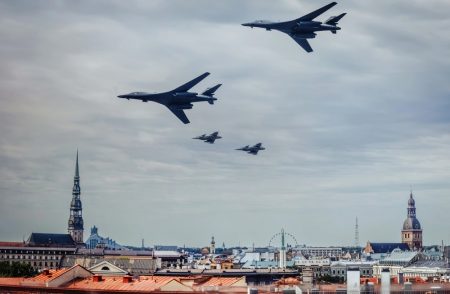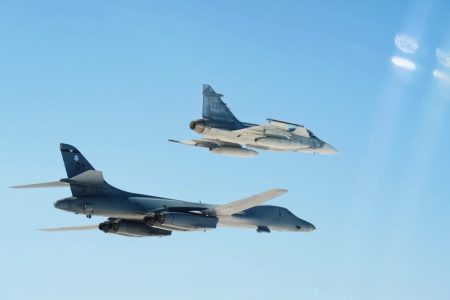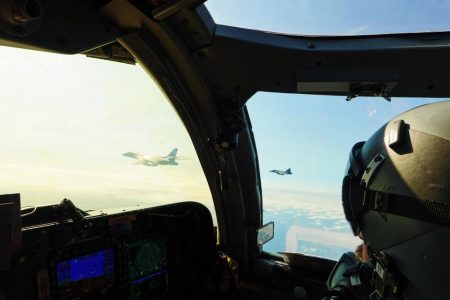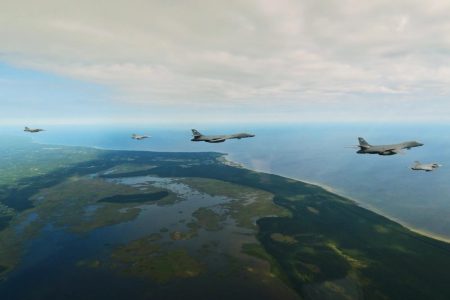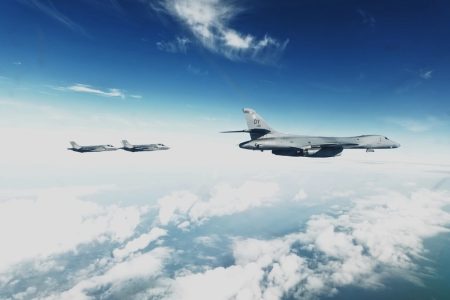At 140 feet tall, the Freedom Monument in Riga is a symbol of Latvian independence that survived Nazi occupation and Soviet annexation.
On Aug. 19, the 90-year-old granite-and-copper monument was overflown by another symbol measuring about as long (146 feet) but made of very different materials: a pair of U.S. Air Force B-1B Lancer bombers, flanked by smaller Swedish and Hungarian JAS 39 Gripen fighter jets. Like the statue, the flyover sent a message.
“Such U.S. and Allied flyover maneuvers clearly demonstrate NATO’s presence in the region, transatlantic unity, and commitment to collectively strengthen the security of the Baltic State region,” Latvian Minister of Defence Andris Sprūds said in a statement.
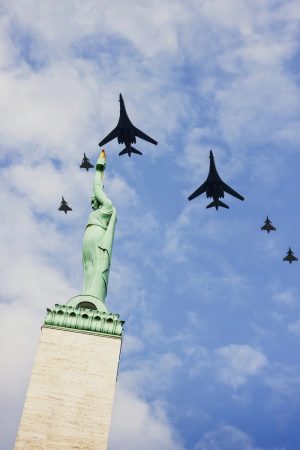 U.S. Air Force B-1B Lancer aircraft and Allied fighter jets flew in formation over the Monument of Freedom in Riga, Latvia, Aug. 19, 2025. (Courtesy photo)
U.S. Air Force B-1B Lancer aircraft and Allied fighter jets flew in formation over the Monument of Freedom in Riga, Latvia, Aug. 19, 2025. (Courtesy photo)Like those of its Baltic neighbors Estonia and Lithuania, Latvian skies are patrolled by NATO nations as part of the alliance’s air policing mission, where fighters from countries with larger air forces guard against intrusions by Russian aircraft.
Hungary has flown NATO air policing missions since joining the alliance in 1999 and started its latest shift over the Baltic earlier this month. New to the scene is the Swedish Air Force, which started its first air policing mission in April after joining the alliance in March 2024 in response to Russia’s full-scale invasion of Ukraine two years earlier.
The U.S. Air Force has also helped with the air policing mission, but the non-nuclear bombers were in Europe for a different purpose. They landed at Ørland Air Station, Norway on Aug. 9 to train with European allies as part of a bomber task force—small international deployments of Air Force bombers meant to reassure allies and build closer ties with their air forces.
“This deployment allows us to train the way we fight—integrated with our NATO Allies, ready and adaptive,” Lt. Col. Eric Alvarez, deployed commander of the Dyess Air Force Base, Texas-based 345th Bomb Squadron, said at the time.
Earlier in the deployment, B-1 crews trained with Norwegian F-35 stealth fighters that practiced penetrating enemy air defenses so that the bombers could destroy targets.
“The B-1B Lancer can’t get close enough alone to poke a hole in that layer, but the F-35s can,” Capt. Lane Musgrave, a project officer for the bomber squadron, said in a release. “So, this Ally-led training with the Royal Norwegian Air Force is incredibly important.”

